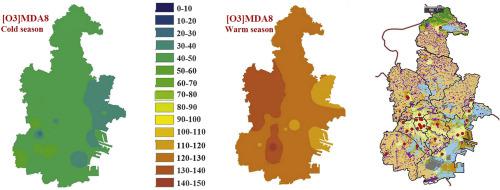当前位置:
X-MOL 学术
›
Atmos. Environ.
›
论文详情
Our official English website, www.x-mol.net, welcomes your
feedback! (Note: you will need to create a separate account there.)
Spatiotemporal ozone pollution LUR models: Suitable statistical algorithms and time scales for a megacity scale
Atmospheric Environment ( IF 4.2 ) Pub Date : 2020-09-01 , DOI: 10.1016/j.atmosenv.2020.117671 Jiawei Wang , Daniel S. Cohan , He Xu
Atmospheric Environment ( IF 4.2 ) Pub Date : 2020-09-01 , DOI: 10.1016/j.atmosenv.2020.117671 Jiawei Wang , Daniel S. Cohan , He Xu

|
Abstract Ambient air ozone (O3), a secondary photochemical pollutant, is seriously harmful to human health. Accurate estimation of O3 exposure requires the ability to monitor O3 surface concentration with a high spatiotemporal resolution. Several spatiotemporal land use regression (LUR) models have integrated meteorological factors based on different statistical algorithms to support such epidemiological studies. From among such various existing statistical algorithms, we aim to identify a high-efficiency modeling method, as well as the most suitable lengths of the modeling period (time scale). Three types of typical spatiotemporal LUR models based on parametric, semi-parametric, and non-parametric statistic methods, respectively, are considered to predict daily ground-level O3 in the megacity of Tianjin, China. Based on monthly, seasonal (cold and warm), and annual time scales, these models include: a series of monthly hybrid LUR (Two-stage) models consisting of two sub-models based on the multiple linear regression (MLR) algorithm, general additive mixed models (GAMMs), and land use random forest (LURF) models. Leave-one-out cross-validation was performed to evaluate the temporal and spatial predictive accuracy of each model using the adjusted coefficient of determination (adjR2CV) and root mean square error (RMSECV). In the GAMMs and LURF models, models using a shorter time scale (monthly models) outperformed those using a longer one. In monthly models, the GAMMs performed the best, with the highest average adjR2CV (0.747) and the lowest average RMSECV (15.721 μg/m3), followed by the LURF models (average adjR2CV = 0.695, average RMSECV = 16.405), and the Two-stage models (average adjR2CV = 0.466, average RMSECV = 23.934). Thus, the modeling format consisting of a shorter time scale and the GAMM algorithm performs relatively well in predicting daily O3 pollution on a megacity scale. These findings can be used to select appropriate modeling methods for epidemiological research of O3 pollution.
更新日期:2020-09-01











































 京公网安备 11010802027423号
京公网安备 11010802027423号